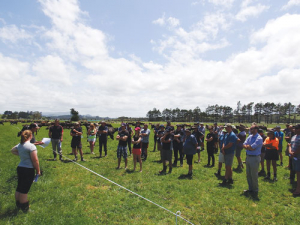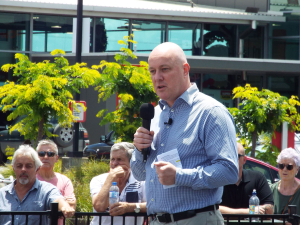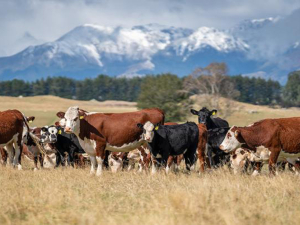The trial, on the Northland Agricultural Research Farm (NARF) is run by the Northland Dairy Development Trust (with NARF) and is funded by DairyNZ, MPI’s Sustainable Farming Fund and Hine Rangi Trust.
Farm working expenses per kg of milk solids were $3.59, $4.20 and $4.01, respectively, for the grass-only, cropping and PKE farms, says Chris Boom, AgFirst Northland, and Kate Reed, NARF farm manager, speaking at a field day this month.
At a $3.90/kgMS payout, the grass-only farm had the highest operating profit at $975/ha followed by the PKE farm at $642/ha and the cropping farm at $444/ha.
A milk payout would have needed to be $6/kgMS before the PKE farm was the most profitable and $18/kgMS before the cropping farm was the most profitable.
The trial started in June 2015 and is now half way through the second year. It will run for another two years. It compares three farmlets at NARF, just north of Dargaville:
1. Grass-only farm: No imported supplement, home grown grass silage may be used. Stocking rate of 2.6 cows/ha (73 cows calving on 28ha)
2. Cropping farm: No imported supplement, crops grown on farm (turnips, fodder beet and maize silage). Stocking rate of 2.8 cows/ha (80 cows calving on 28 ha)
3. PKE farm: Importing PKE as required to optimise profit from pasture. Stocking rate of 2.8 cows/ha (80 cows calving on 28 ha).
The stocking rate is 7% lower on the grass-only farm than on the other two farms. The weather has been relatively kind over the 18 months resulting in good pasture growth and covers on all farmlets.
In response to these conditions, supplement use has been much lower than expected on the PKE farm.
During 2015-16, crops were established on the cropping farmlet: 23% of the farm area was in turnips, fodder beet and maize (silage). Turnip yield was estimated at 9t DM/ha, fodder beet 15.5t/ha and maize silage 22.0t/ha.
For the 2015-16 season, milk production was highest on the cropping farm at 1049kgMS/ha versus 870kgMS/ha on the grass-only farm and 1028kgMS/ha on the PKE farm.
Pasture growth
Good pasture growing conditions prevailed through the 2015-16 season, with calculated pasture growth of 17.4t DM/ha versus an historic annual production of 13.7t DM/ha.
Pasture covers have generally been much higher on all farms than was expected through farm system modelling. The drop in pasture cover during March/April 2016 was largely brought on by all kikuyu pastures being mulched (and Italian ryegrass sown) on each of the farms.
Supplement and crop use
The use of PKE on the PKE farm was well below expected levels during the 2015-16 season, with 469kg/cow being fed versus an expected requirement of 1047kg/cow in an average season. To date, 226kg/cow has been fed during winter 2016 and none during spring.
During spring 2015, crops on the cropping farm were sown – 9% of the farm in maize silage, 7% turnips and 7% fodder beet. Turnips were fed to the cropping cows during January and February 2016, while fodder beet was fed February-early May. Cropped paddocks were sown into either perennial or annual ryegrass.
Cropping for 2016-17 season will occur on 21% of the cropping farm – 7% in maize silage, 9% in turnips and 6% in fodder beet.
Soils at NARF are mostly marine clay and there were high levels of pugging on the ex-crop paddocks during the 2016 winter, challenging the cropping farm.
Milk production
The cropping farm had the highest milk production and grass-only the lowest during the 2015-16 season. Light conditioned cows were dried off on all farmlets from early April. Remaining cows were dried off on the grass-only farm on
May 3 and on the other two farms on May 13.
The grass-only farm started well in the 2016-17 season, being 6% ahead of the previous year while the cropping and PKE farms are 6% and 2% behind last season respectively. On a per-cow basis, the grass-only farm has the highest production.
Labour
Labour and tractor time were recorded as activities over and above the operations commonly required on all farms.
Compared to grass-only, in 2015-16 the cropping farm required 114 hours more tractor time and 313h more moving cows and fences.
The PKE farm needed 100h more tractor time and 193h more moving cows and fences in 2015-16.
The mobs were 70-80 cows – larger mobs would bring more efficiency per cow.
Additional capital is required to develop infrastructure, machinery and extra cows for the more intensive systems.
Body condition score
Body condition score has been assessed every two weeks. The grass-only farm started the 2016-17 season (June 1, 2016) below target and did not achieve the target of 5.0 prior to calving. Body condition was better on the cropping and PKE farms. Mating results have varied between all three herds, however these differences are not considered a consequence of the farm treatment. Once-a-day milking was used for cows with BCS of 3.5 and under from two weeks prior to mating.
NDDT is supported by BNZ, More info can be found on the website at www.nddt.nz


















